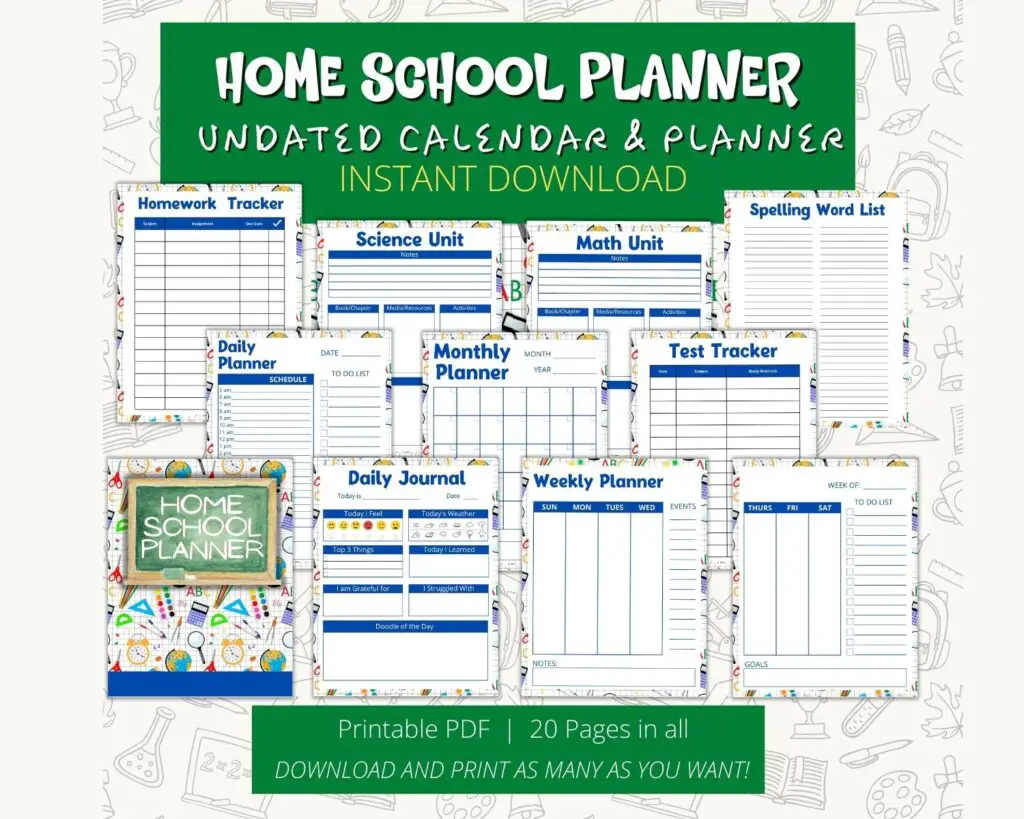Homeschooling can be a rewarding and fulfilling experience for both parents and children, but it can also come with its own challenges, including financial ones.
Homeschooling comes with its own expenses, including materials, resources, and activities. In this article, we’ll share some practical and effective money-saving tips for homeschooling parents. From cutting costs on curriculum and supplies to finding free and low-cost educational resources and activities, we’ve got you covered.

Research and compare curriculum options
There are many different options for homeschool curriculum, ranging from traditional textbooks and worksheets to online courses and educational software. Take the time to research and compare different options to find the one that best fits your needs and budget.
Use Resources You Already Have
Before buying new materials or resources, consider using what you already have at home. For example, you might be able to use household items as manipulatives for math lessons (toy cars, cheerios, M&Ms, etc work great) or use books from your personal library for literature and language arts. If you want some activities to go along with the books to expand your lesson, click through the link.
You can do STEM activities with common household items or recyclables, or move science lessons to the kitchen for some great hands on learning activities for a few quick examples.
Take Advantage of Free Resources
There are many free resources available for homeschooling, including online lesson plans, worksheets, and educational games. Look for free resources that align with your curriculum and goals.
Also, be sure to make use of one of the biggest free resources many people overlook – your local library:
Use Your Local Library for Homeschooling Resources
Your local library can be a great resource for free educational materials, including books, movies, and educational programs. Many libraries offer free classes and workshops. Seriously, if you don’t have one yet – get yourself (and your kids) a library card. Instant access to thousands of books and media of all kinds? Yes, please.
Don’t forget to check out the digital resources that many libraries offer as well,. Many libraries also have apps or programs that give access to digital items such as ebooks, audiobooks, and online courses.
Related Post: Find out why every kids needs a library card!
Your library most likely has computers to use if you need them, and access to wifi.
- Free Wi-Fi & Internet Access
- Computer Terminals
- Word Processing
- Books
- Movies
- Music
- Classes and Lectures
As awesome as libraries are, they don’t have everything you’ll need on your homeschool journey. Here are some things to keep in mind when shopping for your homeschool needs:
Buy Used
Textbooks are expensive. You can save money on books by buying used. In fact, you can save money across the board if you look for lightly used items.
There are many ways to find used textbooks online. Searching eBay, Craigslist, Facebook Marketplace, etc. can yield some good deals when people are often more focused on getting rid of stuff they don’t need rather than trying to get top dollar.
If you live near a college campus, check out student groups and professors’ personal collections. Talk to friends and family members who might know someone selling old schoolbooks. Always shop around. Prices vary depending on where you look.
Online booksellers like Amazon, Barnes & Noble, Books A Million, Chegg, Half.com, and Overstock.com often offer low prices on used books. Compare prices across multiple sites before making a purchase second-hand to make sure you’re getting the best deal.
If buying someone else’s items isn’t your thing or you can’t find what you need used, then it’s on to the next money saving tip:
Shop sales and discounts
Shopping sales and discounts is a no-brainer for anything you may purchase. It applies just as well as homeschool resources and materials. Look both online and in brick and mortar stores.
Sign up for newsletters and follow your favorite retailers on social media to stay up to date on deals and promotions. Back to school sales (mid-late summer in the United States) may be your best bet to stock up. Which brings us to our next tip to cut homeschooling costs:
Stock up or Buy in Bulk
Paper products like notebooks, folders, pens, and pencils tend to go on sale around this time of year. If you’re looking for something specific, such as spiral notebooks or colored pencils, make sure to shop early.
If you’re planning on stocking up on stationery, you’ll save money if you buy larger quantities. Bulk purchases allow you to purchase enough supplies to last throughout the entire school year. Also, many office supply companies offer free shipping on orders over $50. Purchase what you need for the next school year during sales.
Buy Homeschool Supplies as You Go
Sometimes buying in bulk makes sense, and sometimes it’s a lot of extra up front cost when you’re trying to make every dollar count.
You don’t need to buy all your supplies at once. While it’s sometimes handy, you don’t need your whole academic year of stuff all in one shot, especially if you don’t have a lot of space to store it.
By stretching things out and not blowing your budget all at once, you can be more flexible if your plans change. You can also take advantage of any sales and promotions that pop up.
Compare Prices Before Purchasing Anything
This tip isn’t just good advice; it’s actually required. It’s an obvious tip, but we’d be remiss if we didn’t at least mention comparison shopping. If you see a product that looks interesting, but you aren’t sure whether or not it’s worth it, you should check online to see if anyone else is selling it for less. Always keep in mind while shopping for school supplies.
Give Educational Toys as Gifts
If you’re looking for ideas for holiday or birthday presents for kids, try buying educational items you can use in your lessons. I known, I know – “Fun” and “Educational” don’t always go hand in hand, but there really are some great options out there. This is a big one for us, to the point where sometimes family members buy our kids science or tech oriented toys (or just more Legos.) A lot of the toys we feature here at STEMtropolis were gifts for our kids, and they have fun playing!
Here’s a few ideas to get you started:
Learning Games
Learning games are a great way to teach children about math, logic, problem solving, etc. You can find learning games for babies, toddlers, preschoolers, elementary school students, middle school students, high school students, and adults. You’d be surprised how you can use games to teach! Check out our we we share some of our favorite board games for some inspiration.
Educational Toys
Educational toys have come a long way, and many stores now actually dedicate some shelf space to STEM toys and kits.
There are toys designed to teach logic and get kids in the mindset of coding and programming. You can check out some of our favorite coding toys here.
Some of our favorite educational toy brands include LEGO (and Duplo and Mega Bloks), K’NEX, or Magna Tiles. Any building or construction toy can teach lessons about engineering and architecture. Lincoln Logs,
Related Post: Are Legos STEM Toys?
Books
Books are always a good choice for anyone. No, we’re not suggesting you gift your kids their text books. Rather you can find books on topics that can apply to some of the lessons you’re planning.
We have a whole series of book reviews to give you some ideas.
Puzzles
Puzzles are excellent activities to engage kids and promote learning. You can look for themed puzzle books to compliment a particular unit in your homeschooling curriculum.
Word puzzles can help with language arts units, and puzzles like sudoku can help with math and logic. Jigsaw puzzles help develop spatial relations and motor skills.
If you haven’t got it yet, download our free STEM word search puzzles to get you started:
STEM Subscription Box
Stem subscription boxes are the gift that keeps coming month after month, and are usually cool hands on activities or experiments that come with everything you need. Check out our STEM subscription box round up.
STEM Kits
STEM kits have evolved way beyond the classic chemistry lab. Most STEM kits have a theme, so you can plan these to supplement some of your lessons or find something your kid is interested in.
We’ve tried a number of “STEM” kits and, while they’re all a bit different, there was something in each one that the kids found fun and entertaining.
Check out our STEM kit buyer’s guide so you know what to look for.
Laminating Worksheets and Printables
If you find yourself endlessly printing out worksheets, you’re probably using paper and printer ink like crazy. A small investment in a laminator can save you some money here. (We use this one, available on Amazon:.)
By laminating worksheets you use multiple times – or for multiple kids – you can print once and use dry erase markers. This works great for chore charts, schedules, assignment boards, etc.
Check out our article on laminating printables for more information.
Consider a Co-op or Group to Share Homeschool Expenses
Joining a homeschool co-op or group can be a great way to save money and share resources with other families. Many co-ops and groups have discounted rates for group activities and events, and you can also split the cost of larger purchases with other members.
Look for grants and scholarships
Some organizations offer grants and scholarships specifically for homeschooling families. Research and apply for these opportunities to help offset the cost of homeschooling.
Online Learning
There are lots of free online teaching sites, like the popular Khan Academy, which offers videos, quizzes, practice tests, and much more.
Depending on the age you’re looking for, you can find some free courses on Udemy, and we have a whole post on free coding classes.
Using YouTube for Homeschooling
YouTube can find a video for almost anything on Youtube (Some educational, some not so much.) When my kids ask about how something works, we’ll often turn to Youtube.
We just watched a series on ancient Roman and Medieval battle tactics, because one of our kids asked what a phalanx was… go figure. We were also talking about how light acts as both particles and waves, and I easily pulled up a video to demonstrate the concept for them. Good stuff!
The point here is not to turn them loose to go down the Youtube rabbit hole, but to curate some content that fits your homeschool needs.
If you want to keep things simple, you could just create a list of videos to watch together or create a playlist of videos that cover different topics. For instance, you could create a playlist called “How To,” where each video teaches a specific skill or concept.
Wrap Up – Save Money on Homeschooling
Educational expenses can add up quickly. To save money and stretch your budget, homeschool families need to be resourceful. Making use of what you already have, giving educational toys as gifts, finding free resources, and smart shopping practices will all be vital on your homeschooling journey.
Now that you’ve saved a bundle, go check out our post on homeschool planning and organization to help keep track of all your supplies and resources.




